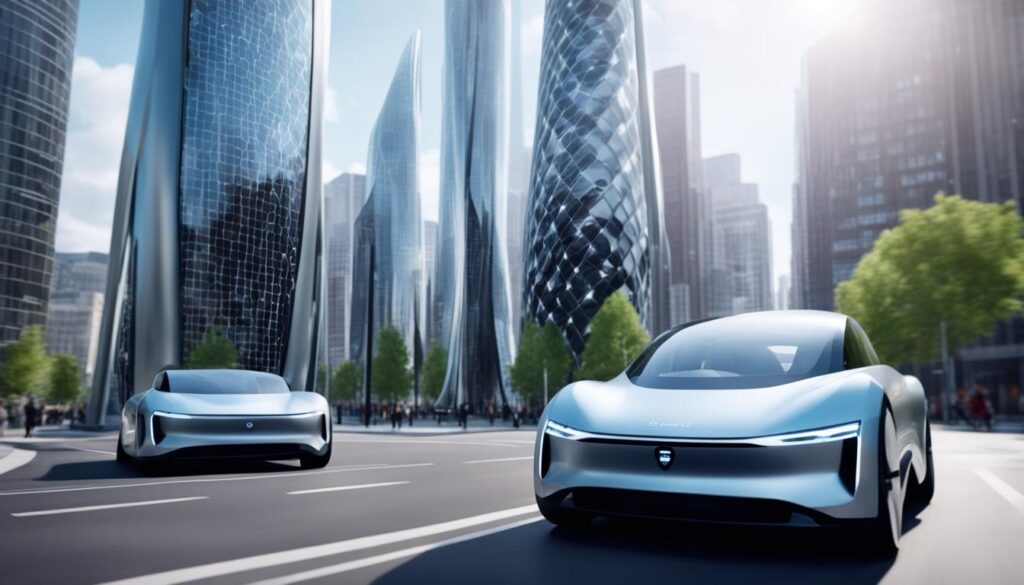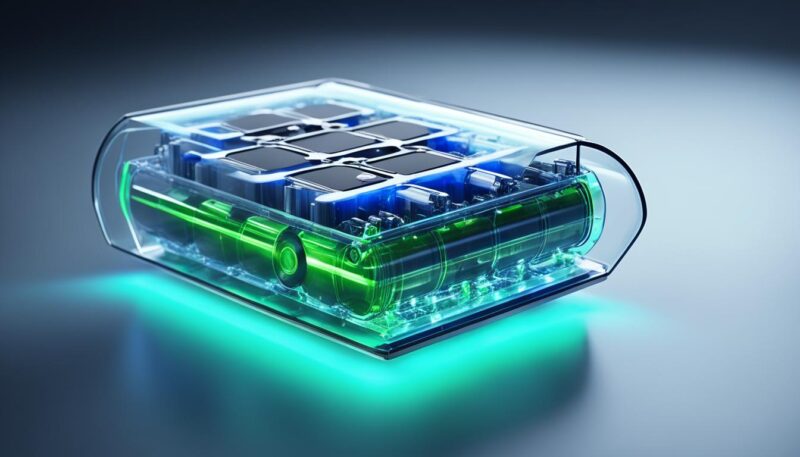As the automotive industry continues its shift towards sustainable transportation and green energy solutions, the development of next-generation batteries has become a crucial area of research. Among these innovations, graphene technology has emerged as a game-changer in the world of energy storage for electric vehicles (EVs). Graphene, a lightweight and incredibly strong material, has the potential to revolutionize the way we power our cars.
Graphene, which is a single layer of carbon atoms arranged in a honeycomb lattice, possesses remarkable properties that make it an ideal candidate for automotive applications. One of the key advantages of graphene is its ability to improve battery technology. By integrating graphene into car batteries, we can unlock benefits such as faster charging, longer battery life, and enhanced safety.
Key Takeaways:
- Graphene technology has the potential to revolutionize the electric vehicle industry.
- Graphene improves battery technology by enabling faster charging and longer battery life.
- Graphene enhances the safety of car batteries by dissipating heat more effectively.
- Graphene offers the potential for lighter weight and more environmentally friendly production methods.
- The scalability of graphene production and integration into existing battery manufacturing processes remain challenges to overcome.
What is Graphene and How Does it Benefit Batteries?
Graphene, a remarkable two-dimensional structure of graphite, is composed of a single layer of carbon atoms arranged in a honeycomb lattice. This lightweight and highly conductive material holds immense potential for revolutionizing battery technology. When incorporated into batteries, graphene offers numerous benefits that enhance their performance, efficiency, and safety.
Graphene is an exceptionally strong and lightweight conductive material that optimizes battery performance and efficiency, making it an attractive choice for various industries.
One key advantage of graphene is its ability to increase battery efficiency by reducing heat buildup during charge and discharge cycles. Its excellent heat dissipation properties minimize the risk of overheating and potential fires, making batteries safer and more reliable. Furthermore, graphene’s high conductivity promotes improved power transfer, enabling batteries to charge and discharge more effectively and efficiently.
In addition to its conductive properties, graphene’s lightweight nature contributes to overall battery weight reduction, which can extend the range of electric vehicles (EVs) and enhance their energy efficiency. By employing graphene in battery production, manufacturers can create batteries that are both lightweight and durable, optimizing the performance of EVs without compromising on safety or longevity.
Moreover, the environmentally friendly production methods associated with graphene contribute to a more sustainable battery manufacturing process. Graphene production techniques are still under development, but the ultimate goal is to establish mass production methods that are cost-effective and minimize environmental impact.
Graphene Benefits for Batteries:
- Enhanced battery efficiency and performance
- Improved heat dissipation and reduced risk of fires
- Lightweight design contributing to longer EV range
- Environmentally friendly production methods
Graphene Battery Example:
| Battery Type | Improved Performance | Energy Efficiency | Fire Safety |
|---|---|---|---|
| Lithium-Ion | ✓ | ✓ | ✓ |
| Graphene-Enhanced | ✓✓ | ✓✓ | ✓✓ |
The table above illustrates a comparison between traditional lithium-ion batteries and graphene-enhanced batteries. The graphene-enhanced batteries exhibit superior performance in terms of improved efficiency, energy utilization, and fire safety, making them a promising advancement in battery technology.
As the production techniques and integration of graphene into battery manufacturing processes continue to evolve, graphene is poised to revolutionize battery technology across various industries, including electric transportation, consumer electronics, and renewable energy storage.
Advantages of Graphene Batteries for Electric Vehicles
Graphene batteries offer several compelling advantages for electric vehicles (EVs). These cutting-edge batteries have been proven to enable faster charging, resulting in shorter charging times compared to traditional lithium-ion batteries. The use of graphene-based electrodes enhances conductivity, leading to improved power transfer and faster charge speeds.
One of the key benefits of graphene batteries is their significantly lighter weight. This characteristic contributes to increased energy density and longer EV range, making electric vehicles more practical for everyday use. Additionally, the superior heat dissipation properties of graphene batteries reduce the risk of battery fires, ensuring safer operation and peace of mind for EV owners.
Furthermore, graphene batteries exhibit exceptional resistance to degradation over time. This attribute results in longer battery life and improved performance, offering consistent and reliable power for electric vehicles. By leveraging the unique properties of graphene, these batteries can deliver enhanced durability and reliability, meeting the demanding requirements of the automotive industry.
Benefits of Graphene Batteries for EVs:
- Faster charging: Shorter charging times compared to lithium-ion batteries.
- Lighter weight: Increased energy density and longer EV range.
- Reduced risk of fires: Superior heat dissipation properties for enhanced safety.
- Improved performance: Resistance to degradation and longer battery life.
Moreover, graphene batteries have the potential to be more cost-efficient and sustainable than other battery technologies. As research and development continue, mass production techniques and cost-effective manufacturing processes will bring further advancements to graphene battery technology, making it a viable and economically attractive option for the electric vehicle market.

Graphene Batteries in the Automotive Industry
Graphene batteries have the potential to revolutionize the automotive industry, particularly in the field of electric vehicles (EVs). As we strive for sustainable transportation and seek green energy solutions, graphene batteries offer a promising solution to reduce carbon emissions and create a more environmentally friendly automotive industry.
One of the main advantages of graphene batteries is their ability to enhance the performance and range of electric vehicles, making them more practical and efficient for everyday use. With faster charging capabilities and longer battery life, EV owners can enjoy a seamless and extended driving experience.
Furthermore, the lightweight nature of graphene batteries contributes to the overall weight reduction of electric vehicles. This reduction in weight not only increases energy efficiency but also allows for a larger payload capacity, making electric vehicles more versatile and attractive to consumers.
“Graphene batteries offer a promising solution to reduce carbon emissions and create a more environmentally friendly automotive industry.”
Graphene batteries also align with the growing demand for sustainable transportation. As we transition towards a greener future, the automotive industry plays a crucial role in reducing our reliance on fossil fuels. By incorporating graphene batteries into electric vehicles, we can facilitate the widespread adoption of EVs and contribute to a cleaner and more sustainable mode of transportation.
Challenges and Future of Graphene Batteries for EVs
Despite the immense potential of graphene batteries for electric vehicles (EVs), there are several challenges that need to be overcome for their widespread adoption. The key hurdles that must be addressed include:
- Scalability of Graphene Production: The mass production of high-quality graphene is still a significant challenge. Techniques must be developed to produce graphene batteries at a larger scale, reducing production costs and making them more accessible for EV manufacturers.
- Establishing Cost-Effective Manufacturing Processes: To make graphene batteries commercially viable, methods for cost-effective manufacturing need to be established. This would ensure that the production costs are competitive with other battery technologies, making graphene batteries an attractive choice for EV manufacturers.
- Integration into Existing Battery Manufacturing Processes: Integrating graphene into existing battery manufacturing processes is a complex task. Further research and development are required to seamlessly incorporate graphene into the current production infrastructure, ensuring efficient and reliable integration.

Despite these challenges, the future of graphene batteries for EVs holds great promise. As technology advances and research progresses, it is expected that these hurdles will be overcome, leading to more practical and economically viable graphene batteries for electric vehicles.
Graphene Battery Technologies and Types
Graphene battery technologies are at the forefront of innovation in the field of energy storage. Researchers and scientists are exploring various types of graphene-based batteries that aim to improve energy storage capacity, lifespan, and performance in electric vehicles. Here are some of the most promising graphene battery technologies:
Graphene Lithium-Ion Batteries
Graphene lithium-ion batteries are one of the most extensively researched and anticipated advancements in battery technology. The integration of graphene in lithium-ion batteries has the potential to enhance their performance by enabling faster charging, improved energy density, and longer lifespans. Graphene’s high electrical conductivity and surface area can enhance the battery’s efficiency and stability, leading to more reliable and powerful energy storage in electric vehicles.
Solid-State Batteries
Solid-state batteries are a next-generation battery technology that replaces the commonly used liquid electrolytes with solid materials. Graphene is being explored as a potential component in solid-state batteries due to its unique electrical and thermal properties. By incorporating graphene into solid-state batteries, researchers aim to enhance their energy density, safety, and overall performance. Solid-state batteries have the potential to revolutionize the energy storage industry, offering improved efficiency and longer-lasting power sources for electric vehicles.
Supercapacitors
Supercapacitors, also known as ultracapacitors, are energy storage devices that bridge the gap between traditional batteries and capacitors. Graphene-based supercapacitors have gained significant attention due to their high power density, rapid charging capabilities, and extended lifespan. Graphene’s excellent conductivity and large surface area enable supercapacitors to store and discharge energy more efficiently and quickly than conventional capacitors. Graphene-enhanced supercapacitors have the potential to provide an alternative to lithium-ion batteries in electric vehicles, offering faster charging times and improved overall performance.
Graphene-Enhanced Lead-Acid Batteries
Lead-acid batteries have been used for decades, particularly in traditional combustion engine vehicles. However, graphene enhancement can significantly improve the performance and lifespan of lead-acid batteries. Graphene’s conductivity and surface area enhance the charge and discharge rates of lead-acid batteries, resulting in improved efficiency and higher energy density. Graphene-enhanced lead-acid batteries have the potential to extend the range and lifespan of electric vehicles, making them a more viable option in the transition to sustainable transportation.
Graphene Sodium-Ion Batteries
Sodium-ion batteries are an emerging alternative to lithium-ion batteries, offering a more abundant and cost-effective source of energy storage. Graphene is being explored as a potential material for sodium-ion batteries, as it can enhance their energy density, stability, and charging capabilities. Graphene-enhanced sodium-ion batteries have the potential to become a viable option for electric vehicles, providing a more sustainable and cost-efficient alternative to lithium-ion batteries.
Graphene Aluminum-Ion Batteries
Aluminum-ion batteries are another promising candidate for next-generation energy storage. Graphene-enhanced aluminum-ion batteries can offer significant advantages, including high energy density, improved cycling stability, and enhanced safety. By incorporating graphene into aluminum-ion batteries, researchers aim to overcome the limitations of existing battery technologies and provide a more efficient and sustainable energy storage solution for electric vehicles.
Comparison of Graphene Battery Technologies
| Battery Technology | Advantages | Challenges |
|---|---|---|
| Graphene Lithium-Ion Batteries | – Faster charging – Increased energy density – Longer lifespan |
– Scalability of production – Cost-effectiveness |
| Solid-State Batteries | – Improved energy density – Enhanced safety – Long lifespan |
– Integration into existing technologies – Cost-effectiveness |
| Supercapacitors | – Rapid charging – High power density – Extended lifespan |
– Energy density limitations – Cost-effectiveness |
| Graphene-Enhanced Lead-Acid Batteries | – Improved efficiency – Higher energy density – Extended lifespan |
– Integration into existing technologies – Cost-effectiveness |
| Graphene Sodium-Ion Batteries | – More abundant source of energy – Cost-effective – Enhanced stability |
– Scalability of production – Performance optimization |
| Graphene Aluminum-Ion Batteries | – High energy density – Improved cycling stability – Enhanced safety |
– Scalability of production – Performance optimization |
Limitations and Potential of Graphene Batteries in EVs
While graphene batteries offer numerous advantages, they also come with certain limitations that need to be addressed for their widespread adoption in electric vehicles (EVs). It is important to understand these limitations in order to optimize the practical abilities and performance of graphene-based batteries.
1. Limited Mass Production Techniques
One major limitation of graphene batteries is the lack of established mass-production techniques for high-quality batteries. This limitation results in higher production costs, making it challenging to make graphene batteries economically viable on a large scale. Overcoming this limitation requires the development of efficient mass-production techniques for graphene batteries, which will enable the technology to be more accessible and cost-effective.
2. Capacity Limitations
The thickness of graphene-based materials used in batteries is often limited, affecting the overall battery capacity. Graphene’s exceptional conductivity and high surface area make it an ideal material for batteries. However, the limited thickness hinders the optimal use of graphene’s potential, which can impact the overall energy storage capacity of the batteries. Researchers and scientists are exploring ways to overcome this limitation by optimizing the material structure and exploring new electrode designs that maximize the utilization of graphene in batteries.
3. Capacity Retention and First Cycle Loss
Graphene batteries demonstrate poor capacity retention and high first cycle loss. Capacity retention refers to the ability of a battery to maintain its original capacity over time. The first cycle loss describes the initial capacity reduction that occurs during the first charge and discharge cycles. These limitations can have a significant impact on the long-term performance and lifespan of graphene batteries. Efforts are underway to improve the capacity retention and reduce the first cycle loss through advanced electrode designs and material modifications.
4. Engineering Challenges
The lack of a bandgap in graphene poses engineering challenges when using it in batteries. A bandgap is a crucial characteristic of semiconductors that allows for the control of the flow of current. Graphene, being a zero-bandgap material, cannot be easily switched off, posing challenges in the design and engineering of battery systems. Researchers are investigating different methods, such as introducing defects or combining graphene with other materials, to overcome this limitation and enable efficient switching in graphene batteries.
Despite these limitations, graphene batteries remain a promising option for electric vehicle batteries. Their unique properties and potential for high energy density make them an attractive choice for large-scale energy storage and the automotive industry.
It is essential to continue research and development efforts to address these limitations and unlock the full potential of graphene batteries. Overcoming these challenges will pave the way for practical and efficient graphene-based batteries that can meet the demands of the electric vehicle industry and contribute to a sustainable future.
Conclusion
Graphene batteries hold immense potential to revolutionize the electric vehicle industry, offering a range of advantages including faster charging, lighter weight, improved performance, and increased safety. Despite the challenges of mass production and cost-effectiveness, the integration of graphene batteries in electric vehicles is expected to become more practical and economically viable in the near future.
These graphene batteries align perfectly with the growing demand for sustainable transportation and green energy solutions, paving the way for a greener and more environmentally friendly automotive industry. By utilizing graphene technology, electric vehicles can become more efficient and contribute to reducing carbon emissions, making sustainable transportation a reality.
As research and development efforts continue, graphene batteries are poised to play a pivotal role in the future of battery technology for electric vehicles. With ongoing advancements, we can expect to see even greater improvements in performance and energy storage capacity, making electric vehicles more accessible and practical for the masses.









